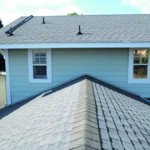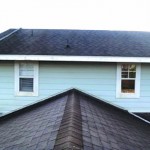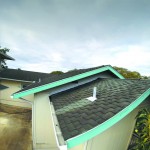Is your roof covered in black streaks? Or has it completely changed to a much darker color than it originally was? If so, then chances are your roof is not dirty, but actually infested by billions of microscopic organisms known as Gloeocapsa Magma.
Gloeocapsa Magma is an aggressive strain of mold that is reeking havoc on roofs and homes (particularly under eaves) in Hawaii. The state’s wet and humid environment is extremely conducive to the growth and constant spreading of this mold. Couple this with the abundance of its main source of food — the limestone filler currently used in shingles instead of asbestos —and it’s the perfect environment for colonizing.
Think about it: If something is a microscopic organism (Gloeocapsa Magma), then how many millions of these organisms does it take to become visible to the human eye? Your roof is infested.
Is this mold bad or damaging? The answer is absolutely yes. This mold lands on your roof and begins to lay down a plethora of filament root systems. These roots burrow down into your asphalt, wood shingles and even tile and metal roofs. These roots then begin to feed on the limestone and deteriorate the roof through photosynthesis. The waste that is produced from this decomposition is very acidic, so it causes even more destruction to the roof system. Decomposition of the shingle allows the granules, which are the only protection your roof has from the sun, to become loose and wash or blow away. As the roof changes temperatures throughout the day, it expands and retracts, which allows these roots to grow even more and create fissures and cracks.
- After
- Before
- After
- Before
This mold has also been known to create some health concerns. Allergies and sick building syndrome are among the most common.
If you have a roof that is rated at 25 years and it doesn’t make it past 15-18 years, is that acceptable? Envirowash Hawaii LLC, Hawaii’s only SoftWash-certified company, says that by not treating the mold on your roof, you could decrease its longevity by as much as 25 percent. This translates to a lot of money being left on the table.
Also, the darkening of the roof can raise temperatures in the attic and throughout the house by up to 25 percent. The hotter the house is under the roof, the more energy (and money) is required to cool the home.
Mike Wedge from Envirowash Hawaii LLC said, “Because we know that this mold is a living organism, we know it is a treatment concern and not a cleaning issue. Do not let anyone pressure wash your roof!”
It is wise to seek out a licensed, insured, trained and certified Soft Wash professional when considering a roof cleaning for your home. Contact Envirowash Hawaii LLC to learn more about Soft Washing and for a free on site estimate or demo.
ENVIROWASH HAWAII
contact // (808) 313-9000
web // envirowashhawaii.com
See more articles from: Envirowash Hawaii LLC



